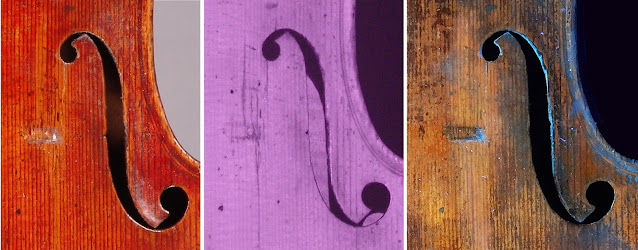ECR Casebook: Crack repairs covered by a varnish that becomes opaque under UV.
Violin by Jack Lott c.1860 | Benjamin Hebbert
The violin in question was made by John Frederick (II) Lott (b.1804, d.1870). He is known as Jack Lott to differentiate him from his father, and because this was the name used by the novelist Charles Reade who wrote his biography, 'Jack Of All Trades'. It is a copy of a Stradivari with a 1716 date on the label. Although it is heavily antiqued, the model is closest to the Messiah. Given that his instruments are difficult to date, his relationship with J.B. Vuillaume, and the Messiah's appearance from Italy in 1854 gives us a terminus post quem for when it was made. He died in 1870. It is consigned to us for sale.
The violin is overall in good condition, but it has suffered damage to the front, including a complex soundpost crack, typical for an event where the soundpost is pushed through the belly. It has been well repaired but over time the dye retouching the repair has faded or been washed away. As a result, evidence of the cracks extending above and below the treble foot of the bridge are easily visible with the naked eye. However as the cracks extend away from the point of trauma, they are easier to glue and there is less aggravation to the original varnish, as a result it is not easy to see how far they extend, and an infra-red photograph is able to show the full extent of the damage.
We found this to be an important example to illustrate the varying properties of different light sources. Under the naked eye it is possible to see evidence of the damage, and the infra-red photographs are excellent for the task of detailing the issue. However, under ultraviolet we get a very different reading. Here we see an area of optically clear over varnish that becomes opaque under UV. Although the pattern of the varnish is an indicator of the repairs beneath, they prove impossible to see. There is no intent to deceive, but in this case UV is not only a poor indicator of damage, but potentially provides a misleading analysis. The triptych of illustrations given below illustrate the importance of analysis in a variety of light conditions. Left to right: Normal Light Conditions (380-750nm), IR=850nm and UV=350nm.


Comments
Post a Comment